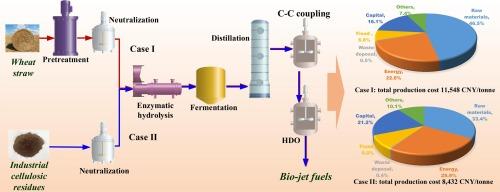基于生物质的生物转化和乙醇水溶液耦合,将木质纤维素转化为生物喷气燃料的技术路线前景广阔:技术经济评估
IF 6.7
1区 工程技术
Q2 ENERGY & FUELS
引用次数: 0
摘要
设计了一种利用木质纤维素生物质通过新技术路线生产生物喷气燃料(可持续航空燃料,SAF)的工艺。根据中国的国情,进一步对该工艺进行了技术经济评估。该工艺路线主要包括第一步通过生物质的生物转化生产生物乙醇,第二步通过 C-C 偶联和加氢脱氧(HDO)从水乙醇中生产碳氢化合物燃料。考虑了两种情况,分别采用小麦秸秆(WS,情况 I)和工业纤维素残渣(ICR,情况 II)作为原料。评估结果显示,情况 I 和情况 II 的生物质原料消耗量分别为 7.2 吨 WS(含水率 5%)或 16.0 吨 ICR(含水率 45%)/吨生物喷气燃料。对于年产 ∼ 20,000 吨生物喷气燃料的工厂,情况 I 项目需要总资本投资 3.82 亿元人民币,情况 II 项目需要 3.68 亿元人民币。在贴现率为 10%的情况下,要实现零净现值(NPV = 0),生物喷气燃料的最低销售价格(MSP)分别为 12,258 元人民币/吨和 8952 元人民币/吨(案例 I 和案例 II)。WS 或 ICR 的价格是影响 MSP 的最敏感因素。对于案例 II 项目,副产品蒸汽的销售价格对 MSP 的影响也非常大。Monte-Carlo 模拟风险分析表明,案例 I 工厂盈利的概率很高(96.66%),而案例 II 工厂在当前生物喷气燃料价格(15,000 元人民币/吨)下的盈利概率甚至高达 99.99%。因此,这项工作可以为利用木质纤维素生物质通过这种新型路线生产生物喷气燃料提供重要的经济信息。本文章由计算机程序翻译,如有差异,请以英文原文为准。

A promising technical route for converting lignocellulose to bio-jet fuels based on bioconversion of biomass and coupling of aqueous ethanol: A techno-economic assessment
A process for production of bio-jet fuel (sustainable aviation fuel, SAF) from lignocellulosic biomass by a novel technical route was designed. Techno-economic assessment of the process was further performed in the Chinese context. The route primarily included a first step of bioethanol production from bioconversion of biomass and a second step of hydrocarbon fuel production from aqueous ethanol by C–C coupling followed by hydrodeoxygenation (HDO). Two Cases were considered, in which wheat straw (WS, Case I) and industrial cellulosic residue (ICR, Case II) were employed as feedstock, respectively. As revealed by the assessment results, the consumption of biomass feedstock is 7.2 tonnes WS (5 % moisture content) or 16.0 tonnes ICR (45 % moisture content)/tonne bio-jet fuel for Case I and II processes, respectively. For a plant with an annual capacity of ∼20,000 tonnes bio-jet fuel, a total capital investment of 382 MM CNY is needed for Case I project, while 368 MM CNY needed for Case II project. The minimal selling prices (MSPs) of the bio-jet fuel to achieve zero net present value (NPV = 0) at a discount rate of 10 % are 12,258 CNY/tonne and 8952 CNY/tonne for Case I and II processes, respectively. The price of WS or ICR is the most sensitive factor affecting the MSP. For Case II project, the selling price of by-product steam also shows very significant impact on the MSP. Monte-Carlo simulation for risk analysis suggests that there is a high probability (96.66 %) for Case I plant to be profitable, while the probability of Case II plant is even as high as 99.99 % at the current price of bio-jet fuel (15,000 CNY/tonne). This work thus can provide important economic information for production of bio-jet fuel from lignocellulosic biomass by this novel route.
求助全文
通过发布文献求助,成功后即可免费获取论文全文。
去求助
来源期刊

Fuel
工程技术-工程:化工
CiteScore
12.80
自引率
20.30%
发文量
3506
审稿时长
64 days
期刊介绍:
The exploration of energy sources remains a critical matter of study. For the past nine decades, fuel has consistently held the forefront in primary research efforts within the field of energy science. This area of investigation encompasses a wide range of subjects, with a particular emphasis on emerging concerns like environmental factors and pollution.
 求助内容:
求助内容: 应助结果提醒方式:
应助结果提醒方式:


